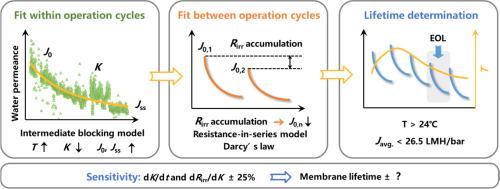全尺寸膜生物反应器可持续管理中膜寿命的预测建模
IF 12.4
1区 环境科学与生态学
Q1 ENGINEERING, ENVIRONMENTAL
引用次数: 0
摘要
膜寿命的准确预测是污水处理全尺寸膜生物反应器(mbr)成本效益和可持续运行的关键挑战。在这项研究中,我们建立了一个数学模型,通过整合达西定律、串联电阻理论和中间阻塞模型,来预测膜在多个操作周期中的寿命。通过循环内拟合可以得到三个参数:J0(初始水渗透率)、Jss(稳定水渗透率)和K(结垢常数)。引入温度系数来量化季节对膜水渗透的影响,不可恢复的污垢阻力作为连接循环内和循环间渗透变化的桥梁。该模型使用20万 m³/天的全尺寸MBR的7年数据进行了校准和验证,在预测渗透率变化方面取得了很高的准确性。评估了两种替代策略:没有预测模型的传统替代策略(5.5年)产生的成本较高(346,088美元/箱),而模型引导的替代策略(6.9年)降低了17.5%的成本。敏感性分析表明,膜寿命对污染速率和不可恢复的污染物积累非常敏感,这凸显了材料优化和有效清洁策略的重要性。这项工作为膜寿命预测提供了一个可解释的框架,使运营商能够优化更换时间,识别关键影响因素并做出可持续的膜管理决策,同时还支持资源节约型、低碳运营和水务部门的可持续转型。本文章由计算机程序翻译,如有差异,请以英文原文为准。

Predictive modeling of membrane lifetime for sustainable management of full-scale membrane bioreactors
Accurate prediction of membrane lifetime remains a critical challenge for the cost-effective and sustainable operation of full-scale membrane bioreactors (MBRs) for wastewater treatment. In this study, we developed a mathematical model, by integrating Darcy’s law, resistance-in-series theory, and intermediate blocking model, to predict membrane lifetime over multiple operation cycles. Three parameters can be obtained through intra-cycle fitting, including J0 (initial water permeance), Jss (steady water permeance) and K (fouling constant). A temperature coefficient was introduced to quantify seasonal effects on membrane water permeance, and irrecoverable fouling resistance served as a bridge linking intra- and inter-cycle permeance variation. The model was calibrated and validated using 7 years of data from a 200,000 m³/day full-scale MBR, achieving high accuracy in predicting water permeance variation. Two replacement strategies were evaluated: a conventional replacement strategy without prediction model (5.5 years) incurred the higher cost ($346,088/tank), while the model-guided replacement strategy (6.9 years) reduced costs by 17.5%. Sensitivity analysis revealed that membrane lifetime was quite sensitive to the fouling rate and irrecoverable foulant accumulation, highlighting the importance of material optimization and effective cleaning strategy. This work provides an interpretable framework for membrane lifetime prediction, enabling operators to optimize replacement timing, identify critical influencing factors and make sustainable membrane management decisions, while also supporting resource-efficient, low-carbon operation and the sustainable transformation of the water sector.
求助全文
通过发布文献求助,成功后即可免费获取论文全文。
去求助
来源期刊

Water Research
环境科学-工程:环境
CiteScore
20.80
自引率
9.40%
发文量
1307
审稿时长
38 days
期刊介绍:
Water Research, along with its open access companion journal Water Research X, serves as a platform for publishing original research papers covering various aspects of the science and technology related to the anthropogenic water cycle, water quality, and its management worldwide. The audience targeted by the journal comprises biologists, chemical engineers, chemists, civil engineers, environmental engineers, limnologists, and microbiologists. The scope of the journal include:
•Treatment processes for water and wastewaters (municipal, agricultural, industrial, and on-site treatment), including resource recovery and residuals management;
•Urban hydrology including sewer systems, stormwater management, and green infrastructure;
•Drinking water treatment and distribution;
•Potable and non-potable water reuse;
•Sanitation, public health, and risk assessment;
•Anaerobic digestion, solid and hazardous waste management, including source characterization and the effects and control of leachates and gaseous emissions;
•Contaminants (chemical, microbial, anthropogenic particles such as nanoparticles or microplastics) and related water quality sensing, monitoring, fate, and assessment;
•Anthropogenic impacts on inland, tidal, coastal and urban waters, focusing on surface and ground waters, and point and non-point sources of pollution;
•Environmental restoration, linked to surface water, groundwater and groundwater remediation;
•Analysis of the interfaces between sediments and water, and between water and atmosphere, focusing specifically on anthropogenic impacts;
•Mathematical modelling, systems analysis, machine learning, and beneficial use of big data related to the anthropogenic water cycle;
•Socio-economic, policy, and regulations studies.
 求助内容:
求助内容: 应助结果提醒方式:
应助结果提醒方式:


